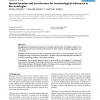Free Online Productivity Tools
i2Speak
i2Symbol
i2OCR
iTex2Img
iWeb2Print
iWeb2Shot
i2Type
iPdf2Split
iPdf2Merge
i2Bopomofo
i2Arabic
i2Style
i2Image
i2PDF
iLatex2Rtf
Sci2ools
BMCBI
2007
2007
Spatial location and its relevance for terminological inferences in bio-ontologies
Background: An adequate and expressive ontological representation of biological organisms and their parts requires formal reasoning mechanisms for their relations of physical aggregation and containment. Results: We demonstrate that the proposed formalism allows to deal consistently with "role propagation along non-taxonomic hierarchies", a problem which had repeatedly been identified as an intricate reasoning problem in biomedical ontologies. Conclusion: The proposed approach seems to be suitable for the redesign of compositional hierarchies in (bio)medical terminology systems which are embedded into the framework of the OBO (Open Biological Ontologies) Relation Ontology and are using knowledge representation languages developed by the Semantic Web community. 1 Background Research activities in the "omics" sciences yield an evergrowing content of experimental data and publications, which are stored in a large variety of databases. For metadata descriptions and med...
BMCBI 2007 | Expressive Ontological Representation | Formal Reasoning Mechanisms | Medical Terminology |
| Added | 08 Dec 2010 |
| Updated | 08 Dec 2010 |
| Type | Journal |
| Year | 2007 |
| Where | BMCBI |
| Authors | Stefan Schulz, Kornél G. Markó, Udo Hahn |
Comments (0)

